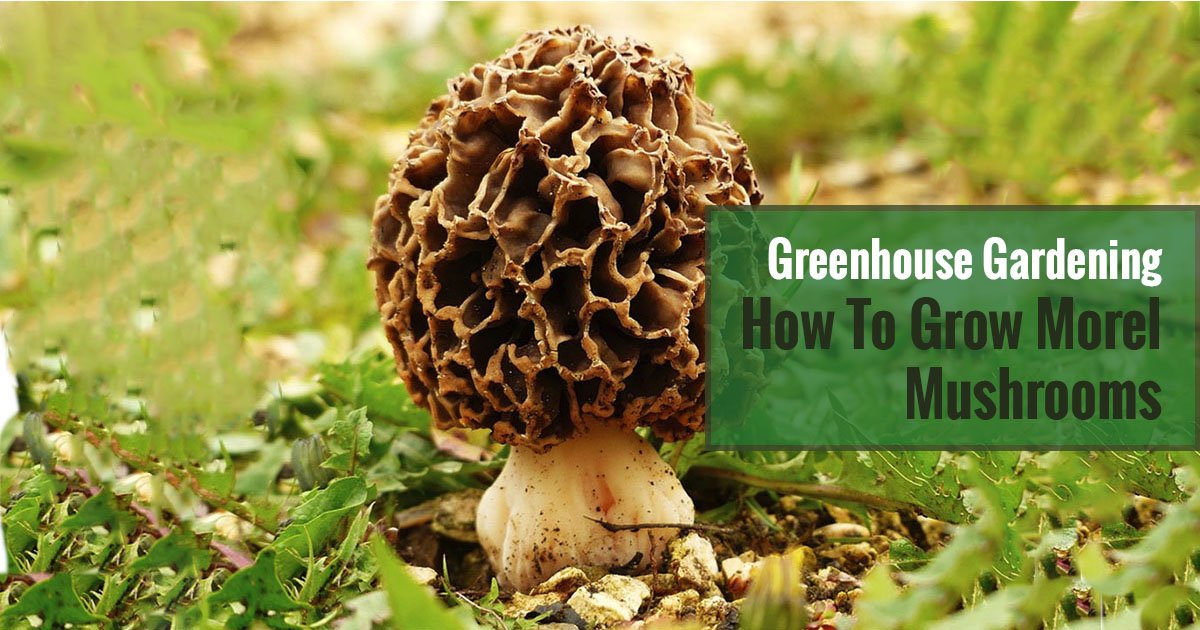

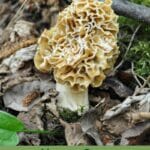
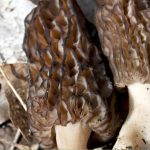

Whether you’re a mycophile or just looking to branch out your gardening skills, there’s no reason you can’t try growing your own morel mushrooms at home. For many years, morel mushrooms have captivated mycologists and culinary enthusiasts alike, thanks to their unique appearance and nutty, rich taste. But because the commercial cultivation of morels is unreliable, they are hard to find in grocery stores, not to mention expensive.
Luckily, there have been many advancements in growing morel mushrooms that allow home gardeners like yourself to try their hand at growing morel mushrooms. Although growing morels isn’t rocket science, it does require lots of patience. Depending on your climate, you can try to grow morels outside or in a controlled indoor environment, such as a clean greenhouse.
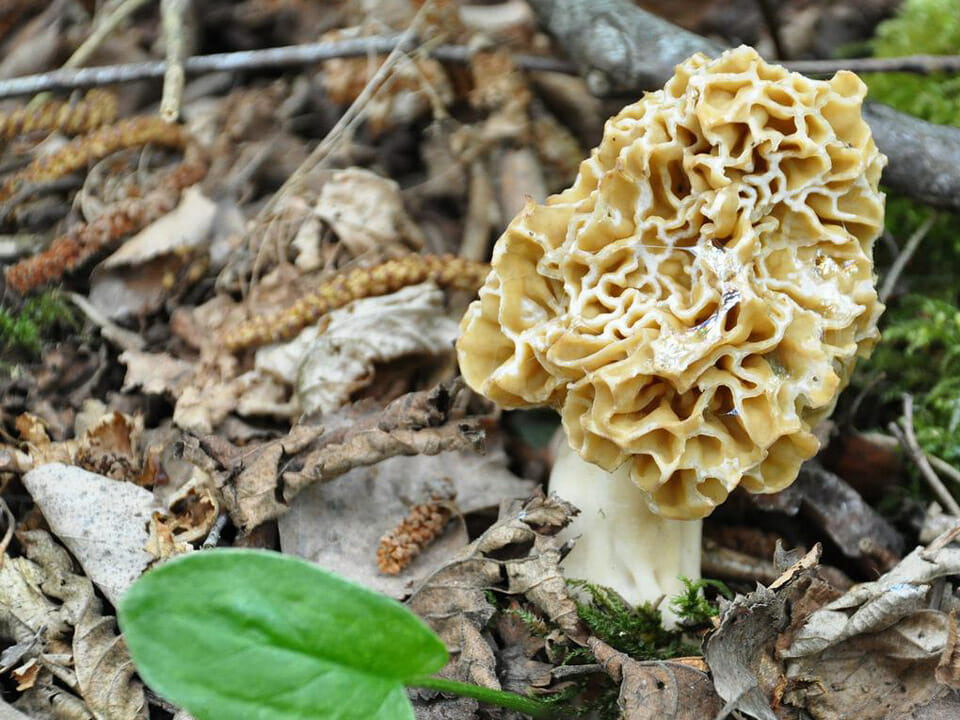
Morels are notoriously difficult mushrooms to grow, but that’s no reason you shouldn’t try. If you’re lucky enough to successfully grow morels, you’ll not only have a tasty mushroom to cook with, but you can also turn it into a potential source of income. So keep reading as we dig deep into the world of morels!
What are morel mushrooms?
Currently, there are around seventy species of morel mushrooms in the genus Morchella. The most popular species (and the one that “morel” usually refers to) is the yellow morel. It can easily be identified by its honeycombed head and hollow interior.
More so than other types of mushrooms, morels are high-value crops that can easily cost as much as $30-60/lb fresh depending on the season (and much more when dried). This exorbitant price is due to a few factors: the demand for morel mushrooms in the culinary world is high, they are notoriously difficult to grow commercially, and their wild growth is not reliable.
The high price of morel mushrooms is one reason why it’s a good idea to try growing them yourself, either outside or in a greenhouse. You can also go foraging for morels in the wild, as long as you are certain you can identify them properly!
How to forage for morel mushrooms
Finding wild morels is not an easy task. Not only are morel mushrooms hard to spot because of their camouflaged appearance, they tend to hide under mats of leaf litter, near dead trees, or around recently burned spots. The typical season for morel foraging is in the spring, when temperatures are still low and the soil is moist. If you live in the western United States, the best time to forage for morels is the first spring after forest fires, specifically in conifer forests.
When foraging for morel mushrooms, it’s important you know how to identify them. Morels have a unique honeycomb cap and are hollow inside. Luckily, you can easily confirm this by slicing a morel lengthwise.
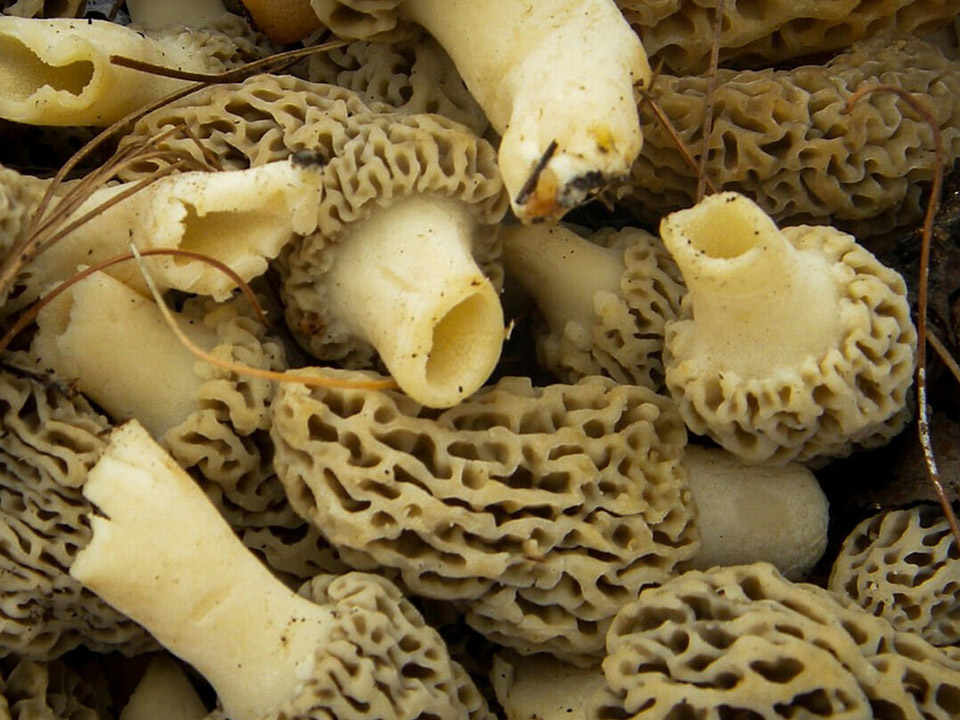
If you’re certain that the mushrooms you’ve gathered are morels, you can take them home and cook them for a delicious, earthy meal! Make sure to cut all foraged morels in half to check for any bugs hiding inside.
What is a false morel?
Although morels are relatively easy to identify thanks to their honeycombed head and hollow structure, they can still be confused with several look-alikes. Most commonly, morels can be confused with false morels, which are poisonous mushrooms.
When eaten, false morels can cause intense gastro-intestinal distress, and in some cases can be deadly. They look similar to true morels but their caps are wrinkled, not honeycombed, and reddish-brown in color, darkening with age. The cap does not connect to the stem but is more like a skirt (look at the image below to see the difference).
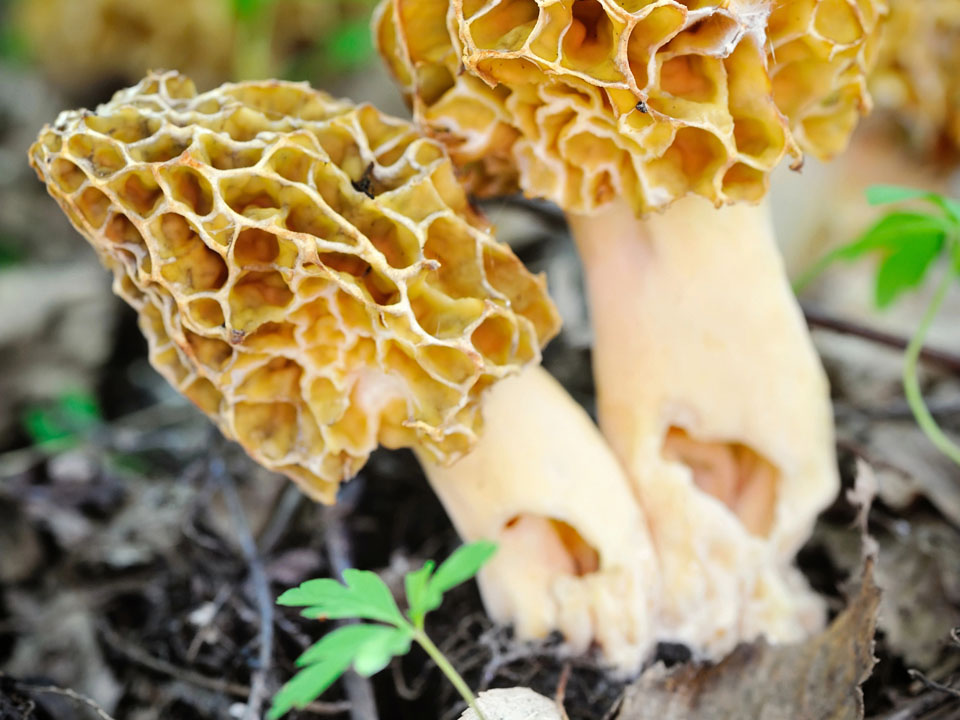
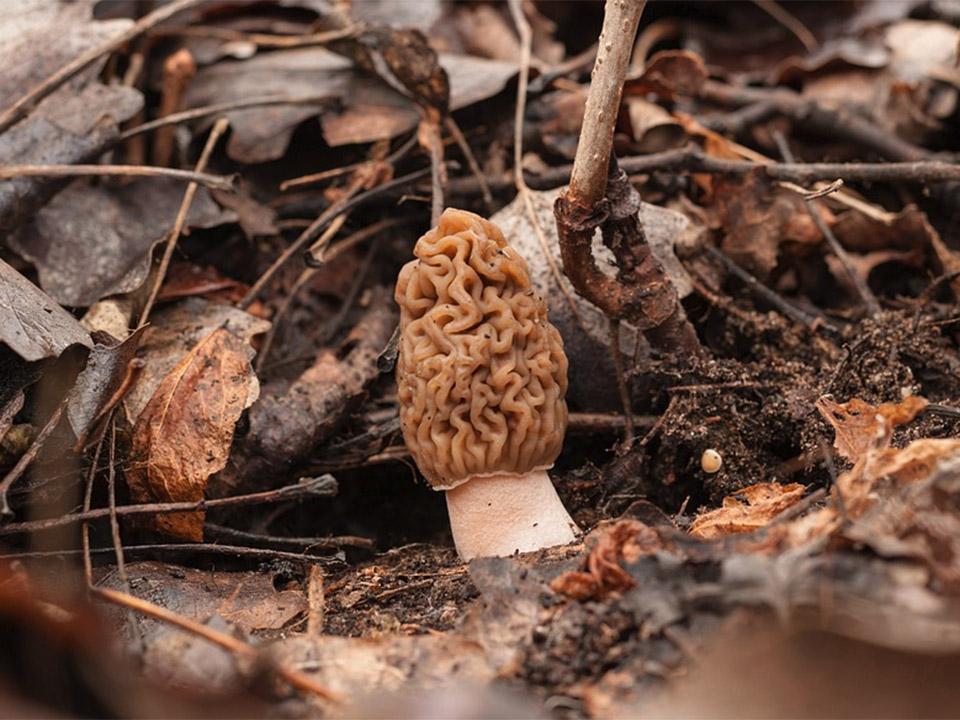
False morels contain the chemical Monomethyl Hydrazine (MMH) which induces vomiting, diarrhea, dizziness, and sometimes even death. MMH has also been found to be carcinogenic.
Other mushrooms that are sometimes confused with morels include thimble morels and stinkhorns.
Always follow the mushroom hunter’s golden rule: when in doubt, go without!
Health benefits of morel mushrooms
Now that we’ve learned to identify real and false morels, it’s time to talk about what makes morels so great! As with other mushrooms, morels boast numerous health benefits, including:
- Excellent source of protein, potassium, copper, selenium, zinc, B and D vitamins
- Powerful antioxidant to protect against heart diseases, stress, and free radicals
- Unusual polysaccharide that stimulates and strengthens our immune system
- Healing characteristics: includes a high level of selenium and niacin which fights cancer
- Natural remedy for diabetes: it can help lower blood sugar
- Can provide your daily iron demands which are 8mg per cup
- Morel essence gives the liver enzymes to regenerate primarily by dispensing antioxidants
- Helps with arthritis by decreasing the symptoms
- Can prevent hyperthyroidism
- Can prevent cardiovascular diseases because it is high in Vitamin B3.
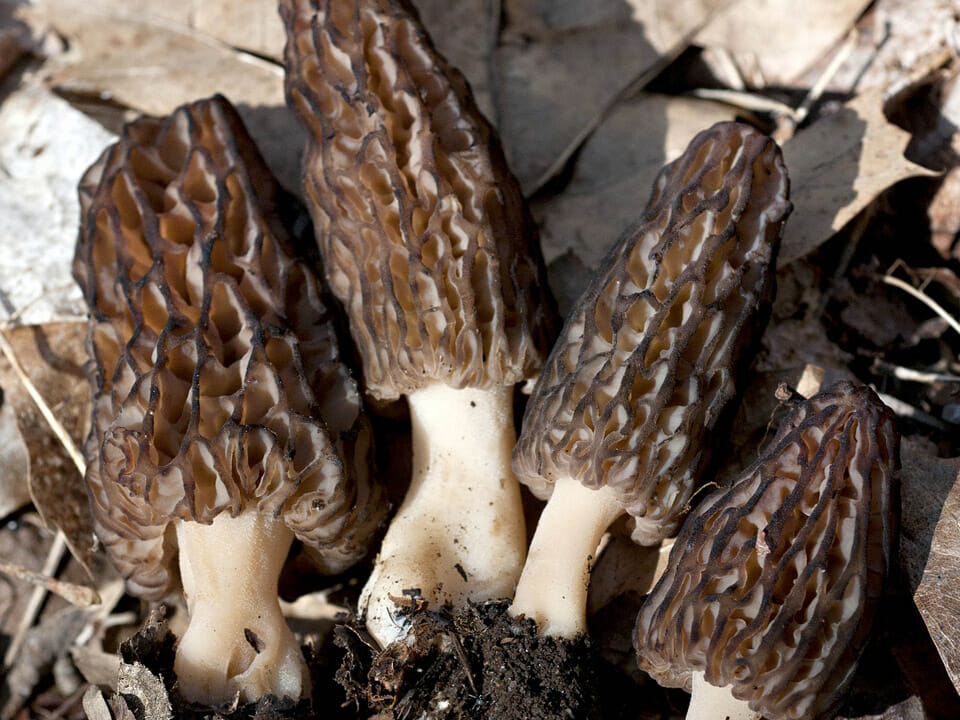
Possible allergic reactions and side effects of morel mushrooms
Eating raw morels can result in some digestive upset, so you should always cook them first. Not only does heat destroy the morel’s natural toxins, but it also helps release the stored minerals and vitamins.
For people with a mushroom sensitivity, it’s possible to experience intestinal discomfort, diarrhea, and vomiting. In rare cases, you might experience superficial swelling in the lips, tongue, or esophagus.
A severe allergic reaction could look like gasping for air, nasal clogging, dizziness, or even anaphylaxis. If you experience any of these symptoms after consuming morels, go to the doctor or ER right away!
Additionally, alcohol consumption stimulates the existence of these allergic manifestations so it’s best to reduce your alcohol consumption when eating morels.
The history of indoor morel mushroom growing
One of the reasons morels are difficult to find and expensive is because they are notoriously hard to grow in an indoor environment. By contrast, the art of growing mushrooms such as white button mushrooms, shiitake mushrooms, and oyster mushrooms indoors has long been perfected, hence their commercial success.
The key to indoor cultivation of mushrooms is mimicking their natural conditions as closely as possible. One of the reasons this is hard to do for morels is because the optimal conditions are difficult and/or expensive to replicate for commercial production; for example, most morel species require cold snap to fruit. Additionally, some species of morels only fruit after wildfires, while others rely on a symbiotic relationship with trees to fruit.
It wasn’t until 1982 that Ronald Ower, Gary Mills, and James Malachowski patented a triumphant indoor morel growing system. A similar growing system has since been outlined by Peter Dilley here.

Now that we’re becoming more familiar with this mysterious fungus, growing morel mushrooms in your garden or greenhouse is more viable than ever. Keep in mind that they are delicate mushrooms to nurture, and it can take several years before you see results. We’ve outlined the three most popular techniques for growing morels below.
Techniques for growing morel mushrooms in a greenhouse
By now you should know that morels are not the easiest mushroom to cultivate, but it sure is rewarding should you be successful! There are a handful of ways to grow morel mushrooms at home. Some methods are easier, while others should only be attempted by experienced mushroom growers. Let’s have a look at the top methods below.
Growing morel mushrooms outdoors
The simplest way to grow morel mushrooms at home is to try to do so outdoors. We know, not technically a greenhouse, but we’ll get to that shortly! Since the key to growing morel mushrooms is mimicking their natural environment as much as possible, you might as well use that to your advantage.
The spawn method
Just as you wouldn’t plant a garden without seeds, you can’t start growing mushrooms without the necessary spores. One of the ways to introduce spores to your dedicated mushroom growing area is by obtaining a mushroom spawn, or a substrate that’s been inoculated with one type of mushroom spores.
The simplest way to obtain a spawn is by buying a morel mushroom kit from a reputable supplier such as this one. Most spawn kits come with instructions, so make sure to follow those closely. Typically, they’ll look something like this:
- Prepare the mushroom bed between summer and fall or in a climate where there is a transition of seasons; most kits are enough for a 4ft x 4ft square. Make sure to pick a shady spot that remains cool throughout the day.
- The mixture of soil that works best for morels is mostly sandy soil with some gypsum and peat moss. Gypsum has calcium sulfate which helps develop the size of the mushroom caps.
- If you’re growing a burn species of morel, simulate a post-forest fire environment by adding wood ash to your soil.
Spread your morel spawn into the top layer of the bed. - Add organic material on top of the spawn such as wood chips or leaves.
Water well. Mushrooms thrive in moist, not soggy soil, so keep an eye on soil moisture and add water as needed.
Then, the hardest part: wait. It might be weeks, months, or even years before your morels fruit. Don’t be discouraged if no mushrooms appear right away; the mycelium are probably hard at work underneath the soil surface. Once the morels start fruiting, they can produce mushrooms for a few years!
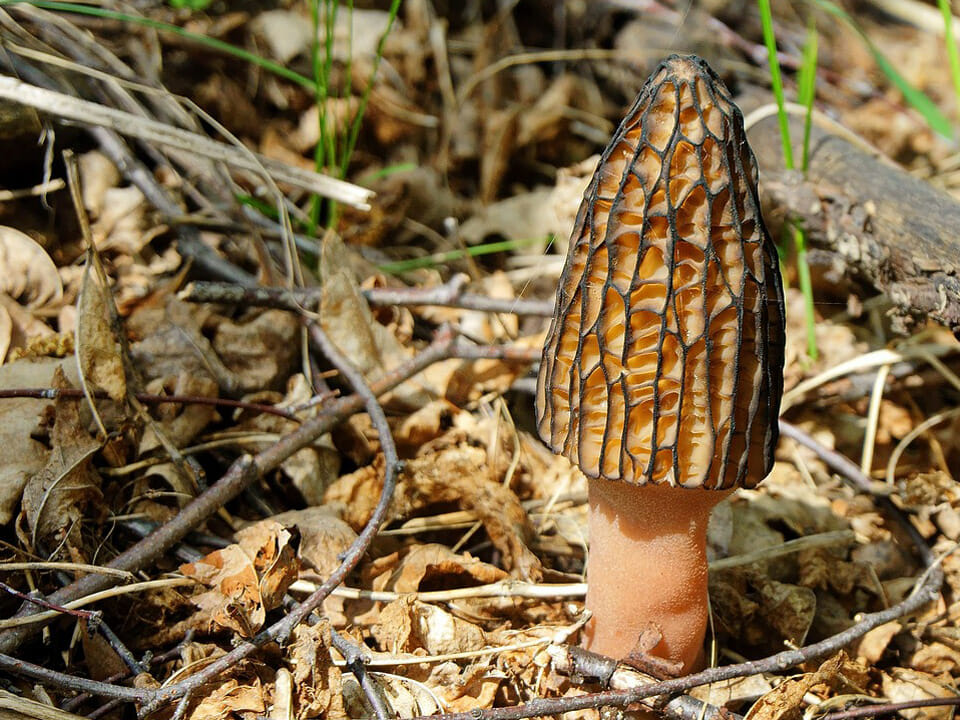
The spore slurry method
A spore slurry is a solution of water, salt, sugar, and spores. The spores are suspended in water and used to inoculate outdoor beds or fallen logs.
You can also make your own spore slurry following these steps:
- Begin with clean, non-chlorinated water in a sterile container.
- Combine a pinch of salt and about 1 Tbsp of molasses to the water. Stir well to combine.
- Add a few fresh morels and allow the mixture to sit in a closed container in a warm room for 1 to 2 days.
- At this point, strain the mushrooms. You should be left with a fluid filled with millions of spores.
Once you have your spore slurry, you can spread it over your prepared bed (see “the spawn method” section above for more details). You can also inject it into a fallen log.
The spore slurry method is one of the simplest and most affordable ways of growing your own morels, but it can be fussy and unpredictable. Be patient!
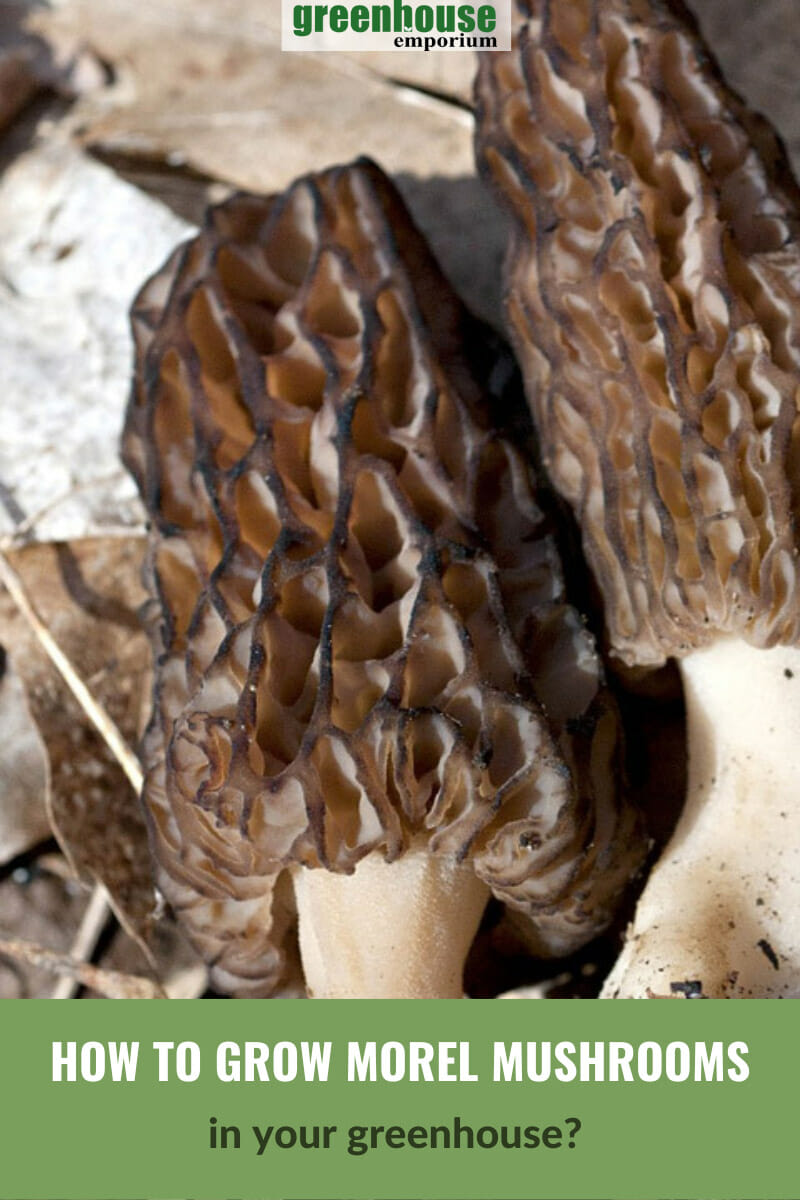
Indoor morel cultivation – How to grow morel mushrooms in a greenhouse
Although difficult, it is possible to grow morel mushrooms indoors. Since the 1982 morel growing patents, many advancements have been made to make morel farming a more viable business.
For the hobby greenhouse gardener, growing morel mushrooms can be a fun (and potentially rewarding) side project to try in a unique controlled environment. Here are some key points for growing morel mushrooms in a greenhouse:
- Use metal trays or cake pans with drainage holes as fruiting trays.
- Clean and sterilize your trays, surfaces, and tools with 5% bleach.
- Add a layer of suitable substrate to each tray, for example a mix of 50% organic matter, 30% potting soil, and 20% sand. You can add powdered limestone to increase the soil pH slightly.
- Water the substrate and let drain before adding the spawn or slurry to each tray.
- Store the trays in a dark spot with a temperature between 65°F to 70°F with 90% humidity.
- In 4 to 6 weeks, you should hopefully notice solid masses of mycelium or schlerotia on the surface of the substrate.
- At this point, place the trays in a fridge at 39°F for several weeks.
- Remove from the fridge and keep the trays at around 72°F with a relative humidity of over 90%.
- Wait, and harvest any mature morel mushrooms that develop!
Note: it’s important to pasteurize your growing medium to remove any bacteria and competing fungi. You can do this with a pressure cooker or steamer!
Common morel cultivation issues
These are some well-known issues in growing morel mushrooms. The growing instructions might seem easy, but failure rates are high. Here are some things that could reduce your chances of success:
- Lack of moisture: Morels need a moist environment. A misting system will be of great help.
- Too much moisture: A soggy environment is ideal for bacterial and mold growth which may prevent morels from developing.
- Incorrect temperature: Morels thrive best when the soil is between 55°F and 59°F.
- Bad spawn: There may be an unknown issue that prevents your spawn from developing properly. Unfortunately, there’s no easy way to identify this. The best way to mitigate this risk is by starting several batches with different spawn.
How to harvest morels
To harvest morel mushrooms, use a sharp knife to cut them free at the stem. Alternatively, you can just pull or pinch the mushroom loose from the substrate. Brush off surface dirt and bugs, then place your morels in the fridge until you’re ready to cook them. Enjoy!
Make sure to check out our guides on how to grow portobello and wine cap mushrooms, too!

